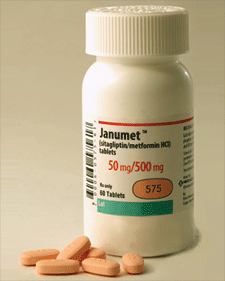Product
Janumet
Approval Date
March 30, 2007
Release Date
May 2, 2007
Company
Merck
Class
Antihyperglycemic (dipeptidyl peptidase-4 inhibitor (DPP-4) + biguanide)
Indication
Adjunct to diet and exercise to improve glycemic control in patients with type 2 diabetes who are not adequately controlled on metformin or sitagliptin alone or in patients already being treated with the combination of sitagliptin and metformin.
Active Ingredient
Sitagliptin 50mg, metformin (as HCl) 500mg; tabs.
Agency Roster
Draftfcb Healthcare (professional, US)
Noesis (professional, global)
Interlink Healthcare Communications (medical education)
The Market
| Diabetes, non-insulin combos US sales ($000s) last 5 years | |
| 2006 |
$551,970 |
| 2005 |
$516,083 |
| 2004 |
$899,072 |
| 2003 |
$678,860 |
| 2002 |
$439,419 |
| Source: IMS Health, Oct. 2007 |
|
| Top 5 Diabetes, non-insulin combos | ||
| Jan.-July ’07 US sales ($000s) | % sales growth over Jan.-July ‘06 | |
|
AVANDAMET (GlaxoSmithKline) |
225,753 |
260 |
|
ACTOPLUS MET (Takeda) |
154,343 |
106 |
|
AVANDARYL (GlaxoSmithKline) |
64,244 |
91 |
|
JANUMET (Merck) |
18,633 |
**** |
|
GLYBURIDE/METFORM (Teva) |
13,348 |
-22 |
| Source: IMS Health, Oct. 2007 |
||
Physician Outlook
MCO decision-makers are watching for Janumet to strengthen its market position, given that it has more time to make inroads with the later-than-expected launch of Galvus, according to our research. Among MCOs, Janumet is almost always viewed as a line extension, a particular advantage for the brand as MCOs consider Januvia’s pricing aggressive.
—Mary McBride, associate VP, GfK Market Measures, October 2007
Also in the Pipeline (according to Adis R&D Insight)
Drug: SYR 322
Manufacturer: Takeda
Indication: Type-2 diabetes mellitus
Active Ingredient: Alogliptin benzoate
Phase: III
Drug: BMS 477118
Manufacturer: Bristol-Myers Squibb
Indication: Type-2 diabetes mellitus
Active Ingredient: Saxagliptin
Phase: III
Drug: Galvus/ LAF 237
Manufacturer: Novartis
Indication: Type-2 diabetes mellitus
Active Ingredient: Vildagliptin
Phase: Preregistration
Source: Wolters Kluwer Health, Oct. 2007
Recent MM&M Coverage
TheTop 60: Draftfcb Healthcare
Merck,Healthy Interactions expand diabetes education program
MM&MAll-Stars Company of the Year: Merck
TheTop 50: Draftfcb Healthcare
TheTop 50: Interlink Healthcare Communications
ProductNews from the 04/03/07 News Brief
MM&MAll-Stars: Company of the Year
MM&MAll-Stars: Agency of the Year
ProductNews from the 12/05/06 News Brief
Pharmacology
Janumet combines the two antihyperglycemic agents sitagliptin and metformin. Sitagliptin, a DPP-4 inhibitor, increases and prolongs the activity of incretins, hormones that play a role in the regulation of glucose homeostasis. Metformin, a biguanide, reduces endogenous hepatic glucose production, decreases intestinal absorption of glucose, and improves insulin sensitivity by increasing peripheral glucose uptake and utilization.
Clinical Trials
There have been no clinical efficacy studies conducted with Janumet, however, bioequivalence of Janumet with coadministered sitagliptin and metformin tablets was demonstrated.
Adverse Reactions
Nasopharyngitis, GI disturbances, asthenia, headache; lactic acidosis (rare, half of the cases are fatal).
Adults
Individualize. Take twice daily with meals. Previously on metformin alone: initially 50mg twice daily of sitagliptin plus metformin dose. Previously on metformin 850mg twice daily: start with 50mg/1000mg twice daily. Previously on sitagliptin alone: initially 50mg/500mg twice daily; may increase to 50mg/1000mg twice daily. Previously on sitagliptin and metformin: switch on a mg/mg basis. Max 100mg sitagliptin/2000mg metformin per day.
Children
<18 yrs: not recommended.
Contraindications
Renal disease or dysfunction. Metabolic acidosis, ketoacidosis. Concomitant intravascular iodinated contrast agents (suspend during and for 48 hours after use). Type 1 diabetes.
Precautions
Confirm normal renal function before starting and monitor (esp. in elderly). Avoid if clinical or lab evidence of hepatic disease. Discontinue if lactic acidosis, ketoacidosis, renal impairment, shock, acute MI, acute CHF, sepsis, or hypoxemia occurs. May need to suspend therapy during periods of stress or if dehydration occurs or before surgery. Monitor hematology (esp. serum Vit. B12 in susceptible patients). Elderly, debilitated, malnourished, deficient caloric intake, adrenal or pituitary insufficiency, or alcohol intoxication: increased risk of hypoglycemia. Pregnancy (Cat.B). Nursing mothers.
Interactions
Cationic drugs eliminated by renal tubular secretion (eg, amiloride, digoxin, morphine, procainamide, quinine, quinidine, ranitidine, triamterene, trimethoprim, vancomycin), furosemide, nifedipine, cimetidine: may increase metformin levels. Avoid excessive alcohol intake (potentiates effects of metformin on lactate). Monitor digoxin. Diuretics, steroids, estrogens, oral contraceptives, phenothiazines, phenytoin, thyroid products, nicotinic acid, sympathomimetics, calcium channel blockers, isoniazid, others that may cause hyperglycemia. ß-blockers may mask hypoglycemia.









